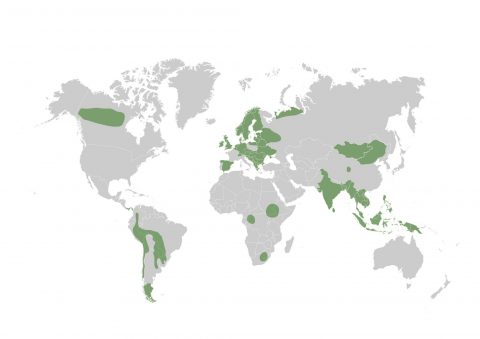
Peatlands
Peat forms where dead vegetation fails to rot, usually because the ground is waterlogged. Soggy peatlands make up about half of the world’s wetlands. They occur in all the world’s regions from tropical rainforest to the Arctic.
We propose rewetting 50 million hectares of peatlands worldwide by 2050 to stem emissions and allow peatlands to resume their role as carbon sinks. If given the technical capacity and access to finance, local communities can contribute significantly to the task of managing and rehabilitating peatlands. We work with communities, industry and to restore peatlands for climate mitigation and adaptation, and facilitate sustainable land use to develop and secure local livelihoods.
The value of peatlands
Although covering only 3% of the earth’s surface, peatlands contain twice as much carbon as all the world’s forests. Peat organic matter is the planet’s biggest terrestrial carbon store, permanently locking up carbon as long as it remains wet. If managed well they can continue to sequester equally large amounts from the atmosphere.
Peatlands are important water stores too. Their sponge-like qualities mean they release water gradually and so reduce the risks downstream of both floods and drought. Peatlands support specialised biodiversity from the insect-eating sundew plants in temperate regions to orangutans in the tropics. They provide food and fuel for local communities, such as purun grass used in woven products and organic fertilisers.
Threats and challenges
Peatlands face numerous threats but drainage is the greatest. Peatlands are drained to access large areas of thinly-populated land for timber plantations and, in the tropics, to cultivate the oil palm. In mountainous areas peat can be vulnerable to degradation through over-grazing, for instance in Mongolia and the Andes.
But, drainage causes land subsidence and floods, and increases the risk of fires in the dried peat. Fires across Russia and Indonesia over the last decade from drained peatlands resulted in toxic smoke pollution and the deaths of thousands of people from respiratory ailments. The fires also released huge carbon emissions on a scale equal to industrial emissions and have significantly contributed to global warming. Making the case for the protection of peatlands can be hard in the face of competing land demands but their protection is just as important as tropical rainforests. Drainage must be urgently phase out if we are to meet global climate targets.
Enablers to scaling up the safeguarding and restoration of peatlands
Long-term success requires wetlands to become of value to local economies, through approaches such as wet agriculture, or “paludiculture”. We already know what type of crops and what their potential is. Demonstrating their wider economic viability is the next step. Momentum and support for conserving and restoring peatlands is growing across civil society, with climate activists and citizen scientists taking up peatland issues. Sharing inspiring community success stories fuels growing interest and action-readiness at grassroot level, especially where the actions are achievable for an individual and make a measurable difference. The increased interest by governments in peatland restoration as a nature-based solution to reverse land degradation, reduce drought and flood risks and greenhouse gas emissions is key to scaling up action. By leveraging the voluntary and mandatory carbon markets, countries can include peatlands in their climate commitments and open up large-scale finance for restoration and conservation. Companies are increasingly interested in adopting voluntary standards for products grown in wet peatland agriculture.
Where we work

We work to safeguard and restore some of the most valuable and threatened peatlands in the world. The areas in green include peatlands where we work for the long-term and where we have ambition to work. This includes safeguarding the biodiverse, mega-peat stores such as those in the Arctic and Congo basins and enabling integrated conservation and restoration programmes in high value peatland landscapes, including those remaining in Europe and Russia, Indonesia, the high mountain wetlands of the Andes and Himalayas, the Nile Basin in Africa, the La Plata Basin and Patagonia in South America.
Partnerships and platforms for change
- We are a founding member and active collaborator in the Global Peatland Initiative.
- We are working closely with Greifswald Mire Centre, combining expertise and joining forces to develop and drive forward a strategy to make a global difference to safeguard, restore, and sustainably use peatlands.
- We have a long-standing relationship with the investment firm Permian Global, with whom we collaborate to protect and recover tropical, carbon-rich wetlands, including peatlands.
- We will work with Commonland and the Landscape Finance Lab to scale up finance for peatland landscape recovery, connecting with additional investors.
- We actively engage in industry round tables including the Round Table for Sustainable Palm Oil and the Responsibly Produced Peat Foundation
- In countries, we work with governments, knowledge institutions and many civil society organisations
